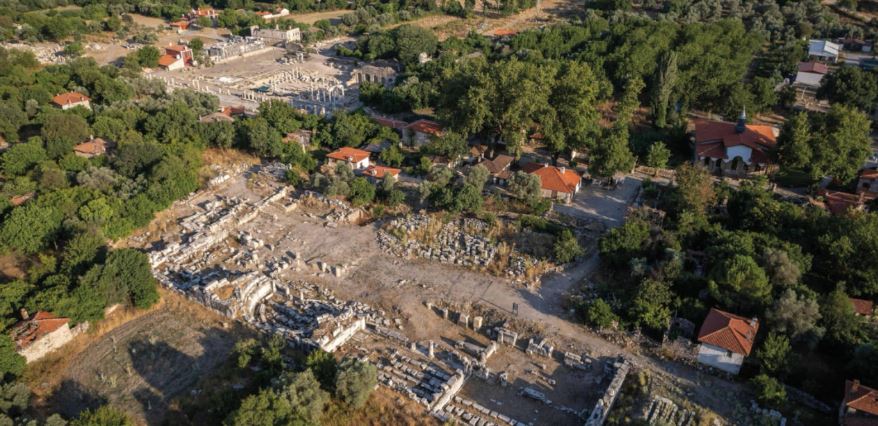GODDESS AT THE CROSSROADS
Archaeology
|May/June 2025
Why a city put its trust in a Greek deity feared throughout the mediterranean

AS EARLY AS THE SECOND century B.C., residents of the city of Stratonicea in western Anatolia honored their patron goddess Hecate, a deity of magic and transitions, with the annual Festival of the Key. This celebration, which was unique to Stratonicea, began with a sixmile-long procession in which a key was carried to the city from a temple dedicated to Hecate in the neighboring town of Lagina. This is the only known temple devoted solely to the goddess. The procession then returned to Lagina through pine forests and past spring-fed reservoirs. Afterward, onlookers from Stratonicea and nearby villages streamed through a monumental arched gateway into the sanctuary for a day of music, prayers, and sacrifices of cattle or sheep on a marble altar in front of the temple. Spectators sat on steps to watch the festivities and partake in an abundant feast. Small groups of worshippers were admitted to the temple's interior to place bunches of grapes or libations of wine in a subterranean pit as an offering to Hecate. "Her priesthood is one of the most important in the city," says art historian Amanda Herring of Loyola Marymount University. "The richest, most elite families are part of her cult, and her rituals are part of their calendar."
Each year, a married couple serving as priest and priestess of Hecate would appoint an unmarried daughter, or another young girl from the community, to carry the key in the procession. Although this key may not have been the actual key to the temple, it was a symbol of the goddess' role as key bearer to the underworld, a function described in many Greek and Roman texts. "Being selected as key bearer was something people were very proud of," says historian Christina Williamson of the University of Groningen. "It was about making young girls visible within the community."
Denne historien er fra May/June 2025-utgaven av Archaeology.
Abonner på Magzter GOLD for å få tilgang til tusenvis av kuraterte premiumhistorier og over 9000 magasiner og aviser.
Allerede abonnent? Logg på
FLERE HISTORIER FRA Archaeology

Archaeology
THE EGYPTIAN SEQUENCE
Until now, the earliest Egyptians to have even part of their DNA sequenced were three people who lived between 787 and 544 B.C.
1 mins
November/December 2025

Archaeology
SOURCE MATERIAL
As early as 40,000 years ago, some hunter-gatherers in southern Africa ventured long distances to procure special types of stone to make their tools.
1 min
November/December 2025

Archaeology
Secrets of the Seven Wonders
How archaeologists are rediscovering the ancient world's most marvelous monuments
13 mins
November/December 2025

Archaeology
ACTS OF FAITH
Evidence emerges of the day in 1562 when an infamous Spanish cleric tried to destroy Maya religion
12 mins
November/December 2025

Archaeology
OASIS MAKERS OF ARABIA
Researchers are just beginning to understand how people thrived in the desert of Oman some 5,000 years ago
8 mins
November/December 2025

Archaeology
FOSSIL FORCE
One of the planet's most successful arthropods, trilobites, abounded in the oceans from about 520 million to 250 million years ago.
1 min
November/December 2025

Archaeology
BIGHORN MEDICINE WHEEL, WYOMING
Perched almost 9,700 feet above sea level on Medicine Mountain in Wyoming's Bighorn Range, the Medicine Wheel is an 80-foot-diameter circular structure made from limestone boulders.
2 mins
November/December 2025
Archaeology
ANCIENT LOOK BOOK
A young woman buried in China's Tarim Basin some 2,000 years ago went to the afterlife accompanied by the height of fashion.
1 mins
November/December 2025

Archaeology
A FAMILIAR FACE
In the early eleventh century, a landslide on the island of Ostrów Lednicki in western Poland caused a hillfort to collapse and slip to the bottom of Lake Lednica.
1 min
November/December 2025

Archaeology
Temples to Tradition
A looted cache of bronzes compels archaeologists to explore Celtic sanctuaries across Burgundy
13 mins
November/December 2025
Listen
Translate
Change font size

